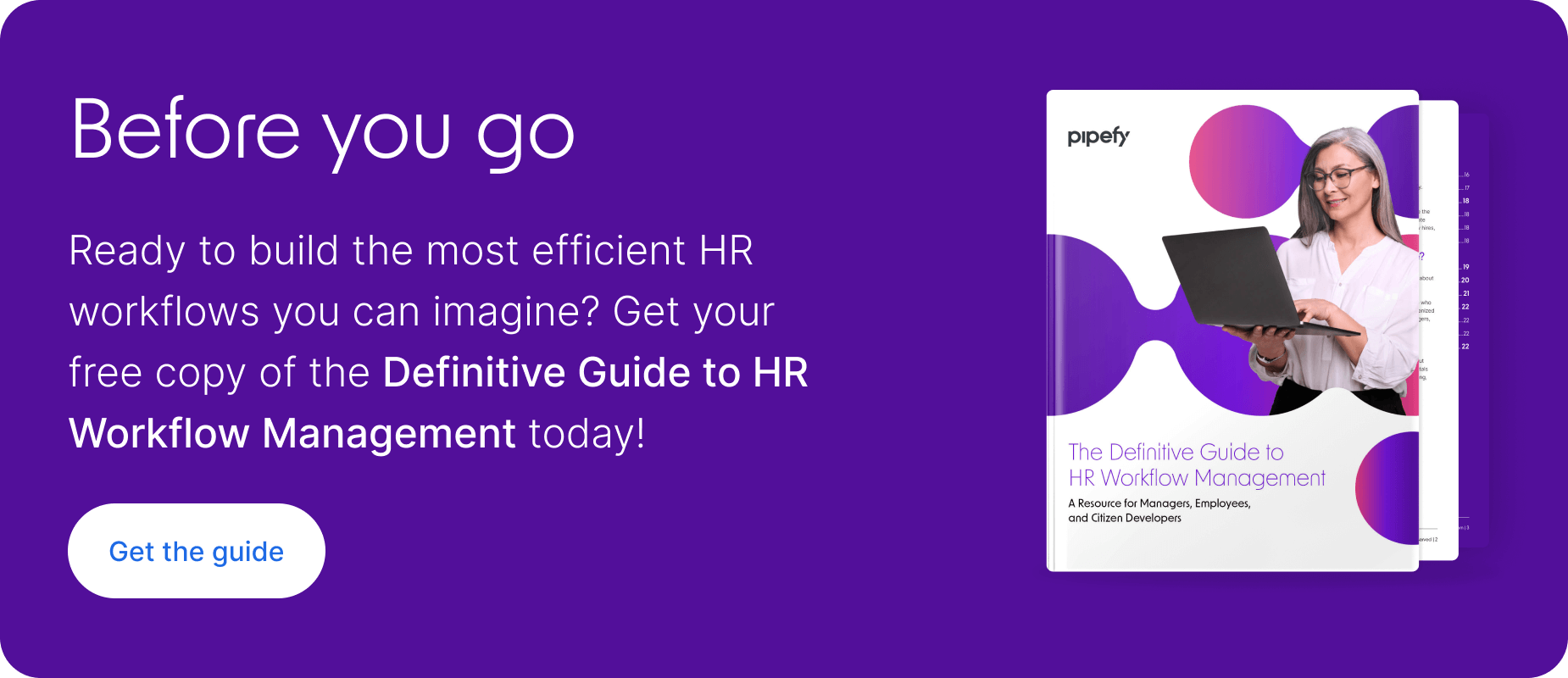ARTICLE SUMMARY
The recruitment process is the sequence of steps to search, sort, select and hire new employees in a company. It includes taking care of details such as writing a good job description, choose between internal or external recruitment, conduct interviews and give feedback. This process is essential to hire employees that will help your company to grow.

What is recruitment?
Recruitment is the process of seeking out, screening, and interviewing candidates in order to find and hire the right person for a job opening. Successful recruitment does so in a timely and cost-effective manner. Prospective candidates may be recruited internally or externally.
Find the right tool to automate your recruitment process with the Buyer’s Guide to Automation Platforms
What is the recruitment process?
In addition to finding candidates for job openings, recruitment is an end-to-end process that can include:
- Determining job requirements and qualifications
- Creating a recruitment plan or strategy
- Finding qualified candidates
- Screening applicants
- Interviewing
- Hiring
Different aspects of the recruiting process may be managed by the HR department, the People Ops team, and/or talent acquisition specialists. In some cases, recruitment is outsourced to a third party. The recruitment process usually follows the HR planning process and precedes both hiring and employee onboarding processes.
Definitive Guide to HR Workflow ManagementDownload now
Importance of an effective recruitment process
Businesses have a lot riding on the effectiveness of their recruitment process, and the ability of their recruiters to fill open positions with the right candidates. While hiring the right people can lead to innovation, increased productivity, and higher profitability, hiring the wrong people can create disruption, impede agility, and cost the company revenue.
Here are three reasons the quality of your recruitment process is important:
The job market is fiercely competitive.
It’s more important than ever to build a recruitment process that’s effective and efficient.
After spiking at the onset of the COVID-19 pandemic, the unemployment rate in the U.S. has consistently fallen. Recently, it reached a low of 3.6% in March 2022. That alone creates a tough market for recruiters, who have to work harder to stand out from the competition and build relationships with candidates. In addition to low unemployment rates, recruiters are also contending with the fallout of the Great Resignation, which shows no sign of slowing down. In March of this year, 4.5 million Americans quit their jobs — a new record high.

In this competitive job market, a successful recruitment process helps recruiters and talent acquisition teams stay nimble and responsive in order to outmaneuver their competitors.
Bad hires are costly.
A competitive job market isn’t the only hurdle recruiters face. They are also tasked with identifying the best candidates and avoiding a potential bad hire. This would be an employee who either doesn’t thrive in the company culture, who always seems to be the source of counterproductive disruptions, or who simply isn’t capable of meeting performance expectations.
Bad hires are costly for businesses. Estimates vary on the cost, but two numbers that stand out are from the U.S. Bureau of Labor and a Career Builder survey:
- A 2003 estimate from the U.S. Bureau of Labor shows that the cost of a bad hire is 30% of an individual’s expected first-year salary.
- In a survey of 2,700 employees, 41% of respondents estimated the cost of a bad hire to be $25,000; another 25% estimated the cost at $50,000. (This survey is a decade old, so if we adjust for inflation these estimates balloon to a $40,000 to $80,000 range.)
While these estimates only account for the costs that can be quantified, a bad hire can also have an impact on morale, employer brand, and other areas of the business. That’s why it’s important for talent acquisition teams to rely on a recruiting process that gives them as much time as possible to strategize, network, review, and interview. The more face time recruiters have with candidates, the better their chances of identifying and weeding out candidates who will ultimately become a liability.
Employer brand makes a difference.
The recruiting process also has implications for the employer’s brand and reputation as a desirable place to work. First impressions are important, because the recruitment process may be the candidate’s first contact with the potential employer. A recruiting process characterized by disorder or a lack of timely follow-ups may give the impression that the work environment is similarly afflicted by chaos. Fragmented workflows and repetitive data entry may likewise signal that the employer is behind the curve in terms of technology or organization.
All told, an employer brand tarnished by an ineffective recruitment process can make it more difficult for recruiters to convince qualified candidates to ink contracts. It may also make it more expensive to attract and retain talent. According to a 2016 study, poor employer brand may cost employers an average of 10% more per hire in order to lure qualified candidates away from competitors.
See how recruiting automation helps teams hire the best & brightestLearn more
Recruitment process steps: how to find and hire the best candidates
The key to improving your recruitment workflow is straightforward and begins with building a structured process. Once you have a consistent, defined process, it will become easier to control and optimize as needed. Let’s look at how a structured recruitment process might unfold:
Step 1: Identify the hiring need(s)
The first step in the recruitment process is identifying the need. Whether it’s the result of turnover and a new hire is needed to replace an employee that’s leaving or a business is growing and needs additional hires to support new initiatives and expand present capacity, recognizing the need is the trigger that sets the recruitment process in motion.
This step is formalized by the completion and submission of a hiring request, either from the HR team or a manager in the department where the need arises.
Step 2: Create the job description
Before the talent acquisition team or recruiter can start seeking out candidates, a job description will need to be created. This includes details such as the position requirements (experience, education, certifications, etc.) as well as a summary of the role and responsibilities.
The job description is usually developed by the hiring manager, but other stakeholders may be involved, especially if the hire is for a new position type. At this stage, details about the compensation range, working conditions, work model, and benefits will also need to be crystallized.
Effective recruitment will also include a structured process for developing and approving the job description.
Step 3: Develop and pursue a strategy
After the hiring need has been identified and the job description built, the recruiter or talent acquisition specialist will be ready to seek out qualified candidates. First, they will want to develop a recruitment plan to help them meet their goal of hiring the best candidate in a specific timeframe and within a defined budget.
The recruitment plan should clearly define the stakeholders and their responsibilities. Who distributes the job description through the various networks and channels? What criteria will be used to sort applicants? Who will conduct interviews? What is the deadline for making the hire?
Step 4: Start the search
Once the recruitment strategy is complete, recruiters can get to work. They may post job openings on social media, and job boards, or circulate them among their network peers. In many cases, this phase of the recruitment process will be managed through the use of a standalone applicant tracking system or an HRIS.
These technologies help recruiters by automating aspects of the recruitment process such as capturing incoming applications, confirming application status, emailing candidates, organizing applications, and routing them to the appropriate reviewer(s).
Internal recruitment benefits
Recruiters have two paths to finding the right candidate for a job: they can hire from within their organization or they can hire from outside it. When the company chooses the first option, this is known as an internal recruitment process.
Recruiting from within the company offers some advantages. First, an internal candidate will already be familiar with the organizational culture, which means they may avoid an adjustment period and decrease the chance that they will ultimately prove to be a bad fit. Second, hiring internally may simplify and speed up the recruiting process, since candidates are established in the HRIS and known to the stakeholders in the hiring process.
Finally, internal recruitment may save the company some money. In addition to not having to spend funds promoting the position, there is evidence that internal candidates can be promoted for less than the cost of an external hire.
External recruitment benefits
In some cases, internal recruitment will not meet the organization’s hiring needs, especially for highly specialized roles, so external recruitment is the path that makes the most sense.
The benefits of hiring from outside the organization include access to a broader pool of candidates, experiences, and skill sets. External candidates may also bring a fresh perspective to the organization, which can be valuable when it comes to assessing business strategy or cultivating an atmosphere of innovation.
Hiring from a pool of external candidates may be advantageous in other ways. Organizations with diversity and inclusion initiatives may wish to consider a wider pool of candidates. Hiring from outside the company may also help prevent internal strife or avoid introducing tension into the workplace.
Definitive Guide to HR Workflow ManagementDownload now
Step 5: Screen the applicants
Regardless of whether your recruitment strategy focuses on internal or external recruitment (or both), all applicants will need to be screened in order to narrow down the pool of candidates and identify the right person for the job.
The screening portion of the recruitment process usually involves several phases. These may include phone screenings, skill assessments, and online or in-person interviews.
Step 6: Make an offer
Once the screening process is complete, it will be time to decide which candidate best fits the position and then make them an offer. This includes drafting an offer letter and possibly getting it approved. Once the offer has been extended, candidates are given a window of time to review and respond.
Step 7: Pivot to the hiring process
If the candidate accepts the offer, then the hiring process begins. The hiring process is a structured series of tasks that must be completed in order to formalize acceptance of the offer and to prepare the new hire for onboarding. The hiring process — and employee onboarding — may be handled by teams other than recruiting or talent acquisition. It’s important that these related processes work together seamlessly.
Common recruiting challenges
In addition to the effect of a low unemployment rate and seismic shifts in employee expectations since the onset of the COVID-19 pandemic, recruiters and People Ops teams face additional challenges when it comes to finding and hiring the best candidates.
Skills shortage
Finding candidates with the right skill set for the job isn’t always easy. This is especially true for manufacturing and IT, two sectors where skills shortages are projected to last through 2030 in the U.S.
Although recruiters can’t hire candidates who simply aren’t there, what they can do is ensure that they are expanding their reach as effectively and efficiently as possible.
One of the easiest ways to do this is through the use of recruiting automation software that integrates with HRIS, ATS, and social media channels. Doing so minimizes the amount of time spent on data entry, maintains consistency across systems, and simplifies sharing job postings across multiple channels.
Difficulty standing out
Tight labor markets create situations where multiple recruiters are talking to a single candidate. That can make it more difficult to stand out and catch the attention of prospective new hires.
One way around this obstacle is to develop a strong employer brand. According to employer brand expert Bryan Adams, an employer brand consists of three elements: reputation, employer value proposition (EVP), and employee/candidate experience.
In Adams’ view, the quality of the employee experience is determined by the clarity of employer expectations and the employee’s ability to meet those expectations. The result is better employee performance and a positive view of working for your company.
Cumbersome application process
Another reason why candidates might choose one job offer over another is the quality and ease of the application process. The application process can be time-intensive, so creating a streamlined process for prospective employees may give you an advantage. But the application process is also a candidate’s first real impression of your company. If the application process comes across as disorganized, it may send a signal about their potential future work environment.
Obstacles for mid-sized companies
In addition to these common challenges, mid-sized companies and emerging enterprises must also contend with budget limitations and fewer resources. Unlike larger enterprise competitors, mid-sized companies may not have large budgets or established employer brands to leverage against their competitors.
In situations where an expensive enterprise HRIS or ATS isn’t a great fit, low-code automation software may be the best option. Low-code gives HR teams an IT-approved tool that relies on a visual user interface to build, modify, and manage processes, including recruitment. Low-code recruitment automation integrates with existing tech stacks and apps to create seamless candidate experiences that effortlessly transition to hiring and onboarding processes.
Impact of recruiting challenges
The most obvious way these challenges impact an organization is that they fail to land the best and brightest candidates. As a result, innovation and productivity may stifle. At the very least, the time-to-hire increases, a situation that drives up the cost of recruitment and which can impact timelines for business initiatives. (For reference, the average length of time it takes to recruit an employee in the U.S. is 23.8 days.)
An inefficient recruiting process can also dampen the morale of your current employees. If teams are short-staffed, burnout rates may increase. It may also give employees the impression that their current workplace is seen as undesirable by outsiders and that truly qualified candidates are going somewhere else.
How to improve your recruiting process
The good news for recruiters and talent acquisition specialists is that improving the recruitment process can go a long way toward connecting with the most qualified candidates and reducing time-to-hire. Here are some of the key components of an optimal recruiting process:
1. Standardization
Consistent recruitment processes improve the candidate experience. Standardization signals to applicants that your team is organized, prepared, and in control. It also makes it easier for your team to plan, track progress, and reduce errors. For example, using a standardized form along with rules and conditionals can prevent missing or incomplete information and reduce the need for additional follow-ups and rework.
2. Integration
Most HR teams rely on an assortment of systems, apps, and tools to promote open positions and manage applicant data. They may also depend on a fragmented collection of workflows and processes between the point where an application is received and the start of the hiring and onboarding process.
By integrating the components of the existing stack — as well as orchestrating all the related recruiting workflows — teams can dissolve data silos and improve candidate experiences. Duplicate data entry is minimized or eliminated, and new hires transition seamlessly into subsequent HR processes such as employee onboarding.
3. Automation
Another way the recruiting process can be improved is through the use of recruitment automation software. Automating elements of the process gives recruits more face time with candidates, maintains consistent communications, and reduces the amount of time spent on repetitive tasks. Low-code automation in particular makes it easy for HR teams to optimize and automate processes on their own, without having to send every change request to IT.
4. Data
HR teams are increasingly expected to help drive business strategy by providing insights into their workforce and the status of HR operations. Using tools and software that organize information and provide dashboards or reports can give People Ops teams the ability to make recommendations to leaders with confidence.
Access to data also brings visibility to the recruiting process, a benefit that helps identify bottlenecks and other optimization opportunities.
Recruiting Email Templates to Attract the Best Talent
Job seekers want you to keep in touch, but that doesn’t mean you have to compose individual emails to each person. With effective recruiting email templates and software that can trigger these emails to send automatically, you can get the attention of the best candidates and build a top-tier team.
What Makes a Great Recruiting Email?
Writing an effective cold email to a prospective applicant is a challenging task. You have to convince them to not only open the email, but read it all the way through, seriously consider your request and respond promptly to let you know they’re interested.
Fortunately, there are a few best practices you can use to improve your chances of potential candidates following through with each step of the process.
Personalize It
People are more likely to interact with an email if it’s personalized. Consider:
- Personalized email messages get 14% more click-throughs and 10% more conversions
- Personalizing a subject line improves an email’s open rate by 17.6%
- Segmented emails get 101% more clicks than non-segmented
Even when using recruiting email templates, you should actively try to identify opportunities where you can drop in information about a candidate’s skills and background. This will be particularly important in cold recruiting emails, but you can incorporate personal data in later phases of the process as well.

Make It About Them
Make sure the content of your email is focused on the candidate. The information that helped you to personalize an email will also help you to keep the candidate at the center of your message.
Remember, you’re emailing someone who isn’t emotionally invested in your company, so don’t focus on how they can help you. Focus instead on how the opportunity can help them. Use as many “you” pronouns as possible and keep the “we” to a minimum.
Keep It Concise
Active job seekers are busy trying to find a new position. Passive job seekers already have work to keep them busy. Instead of asking everyone to fill out a lengthy application, carefully choose your call-to-action for each email.
For example, in a cold recruiting email, you’ll want to keep your ask simple. Maybe invite them to a five-minute call or ask them to fill in a brief interest form (no more than two or three questions). When the person is further along, you’ll need to ask for more, but try to keep it to one request per email, and make sure what you’re asking is appropriate to the stage of the process.
Recruiting email templates for all scenarios
To impress your star candidates, you need to keep them updated on what’s happening with their applications. Have an email template ready for all situations when an application status changes.
Here are some examples to get you started.
Initial contact
This will be your first contact point for passive candidates. Make sure they know you did your research and that you’re not spamming them. Personalization is crucial at this stage.
Hi [FirstName], we saw your profile on LinkedIn and we’re really impressed with your expertise in [skillset]. Would you be interested in using your skills on some innovative new projects? Our team is doing some cutting-edge work in [topic] that we think you’d enjoy being part of.
Invitation to interview
Plan to send an email for each interview stage that candidates go through. One option is to have a single recruiting email template that you can adapt for multiple types of interviews across stages of the recruitment process.
If you have time, though, consider creating different templates for phone interviews, first in-person interviews and follow-ups. That way, you can integrate more details about the candidate and let them know the message is truly personal.
Hi [FirstName], thank you for your interest in [position] at [company]. You seem like a good fit and we’d like to invite you to a [type of interview]. Would you be available on [date] to [speak/meet] with us?
Request for Assignment
If your position requires candidates to complete an assignment or test, you’ll need an email to make that request.
Hi [FirstName], Thanks for taking the time to interview with us. We’d like to move your application forward, and that means asking you to complete a test project to evaluate your skills in [subject]. Details of the assessment are attached. Please let me know if you have any questions.
Rejection
No one likes being rejected, but candidates appreciate it when a company does the courtesy of notifying them when their application isn’t moving forward. Use a brief but friendly template to inform candidates that you’ve decided to go with another applicant.
Try to create a different rejection template for different stages of the process so you can add more personal details and build goodwill with your applicants. That way, if you want them to apply for a role better suited to their skillset later, they’ll already have a good impression.
Dear [FirstName], Thank you for your time in [applying/interviewing] for [position]. We’ve reviewed your qualifications and regret to inform you that we won’t be moving forward with your application. We wish you the best of luck in your career.
Offer of employment
Your employment offer is a critical step in a person’s transition from candidate to employee. The offer email will probably be just part of a more formal offer letter, but you’ll still need to craft a message that’s warm and enthusiastic yet professional in tone.
Hi [FirstName], We’re grateful for all of your time throughout this process, and we’re excited to offer you the position of [job title]. Your offer letter is attached, and I’m happy to answer any questions you might have.
Tap into the talent pipeline
Even when the job market isn’t as competitive as it is today, recruiters need processes that make it easier to connect with a larger pool of candidates. They also need tools that help them build relationships, organize information, and understand how and when they need to optimize their workflows.
Low-code automation brings control and consistency to the recruiting process, as well as creates a unified system of HR processes. The result is better experiences for candidates and employees, and the teams who work with them.






